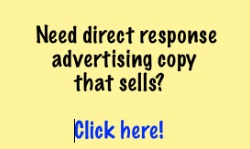Do you make these mistakes in your marketing?
They’re common — I see them all the time — and sadly, I’ve made most of these mistakes myself. Multiple times.
And I still make each of them from time to time. But I’m learning…
Mistake #1: Failing to identify and target ideal prospects
Tens of thousands of businesses across the U.S. could benefit from my copywriting services. Yet few of them are even halfway decent prospects.
Most of them don’t know (or care) what direct response advertising is … don’t believe anyone reads long copy … don’t want to be “salesy” in their advertising … and would never be willing to pay my munificent fee (let alone royalties) even if they could afford it.
Sure, I could try to educate them … try to convince them that my service pays for itself … and so forth. However, in my experience, such effort are almost always entirely fruitless.
I’m far better off with prospects who are already in the direct response business … already know the value of good sales copy … aren’t afraid to sell … and who are used to paying big fees for effective copy.
The same goes for your business. Instead of trying to sell everybody, identify your ideal prospects and sell them instead.
Mistake #2: Failing to regularly contact those prospects (and customers)
I can’t say it enough: no matter how often you currently get in touch with your prospects and customers, it’s NOT enough.
Especially in this day and age, when they’re barraged with advertising 24/7 no matter where they go.
You need to be a consistent voice in their ears, reminding them that you exist and that you have goods and services available that will improve their lives.
Otherwise, you’ll be forgotten faster than you can imagine — and replaced by a competitor who just happens to show up the day your prospect or customer needs whatever you sell.
And yes, this is a case of the pot calling the kettle black, considering you haven’t heard from me in more than a year! In other words, I urge you to do as I say, not as I do.
Mistake #3: Failing to make a compelling offer
With rare exceptions, every message you send to a prospect or customer needs to make a compelling offer.
Don’t just build your brand … send out content … or stay in touch. Instead, make an offer every time you connect with a prospect or customer.
This usually means asking them to buy — but in a compelling way with special savings, extra bonuses, a free gift for stopping by or whatever you can think of to motivate immediate action.
Mistake #4: Not nearly enough proof
Every day, your prospects and customers are hit over the head by thousands of advertising messages flying at them from every direction.
Many marketers try to cut through the clutter by making bigger and bigger promises.
However, you’re far better off if, instead of bigger promises, you offer more and better proof that you can fulfill every promise you make.
This means testimonials, case studies, statistics, scientific citations, demonstrations and, for most businesses (though not all), a money-back guarantee.
Avoid these mistakes and you’ll avoid a lot of pain and frustration. Better yet, your business can’t help but do better. If you’d like help, click here to email me.

